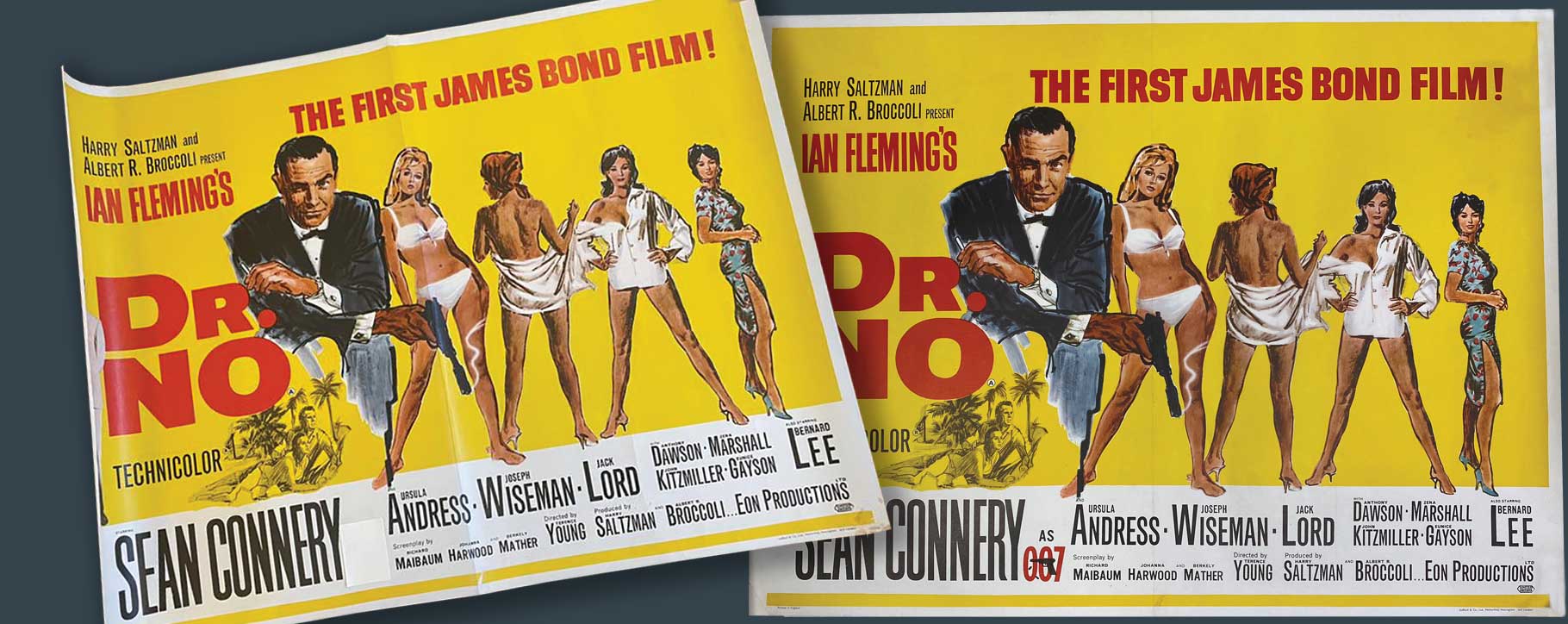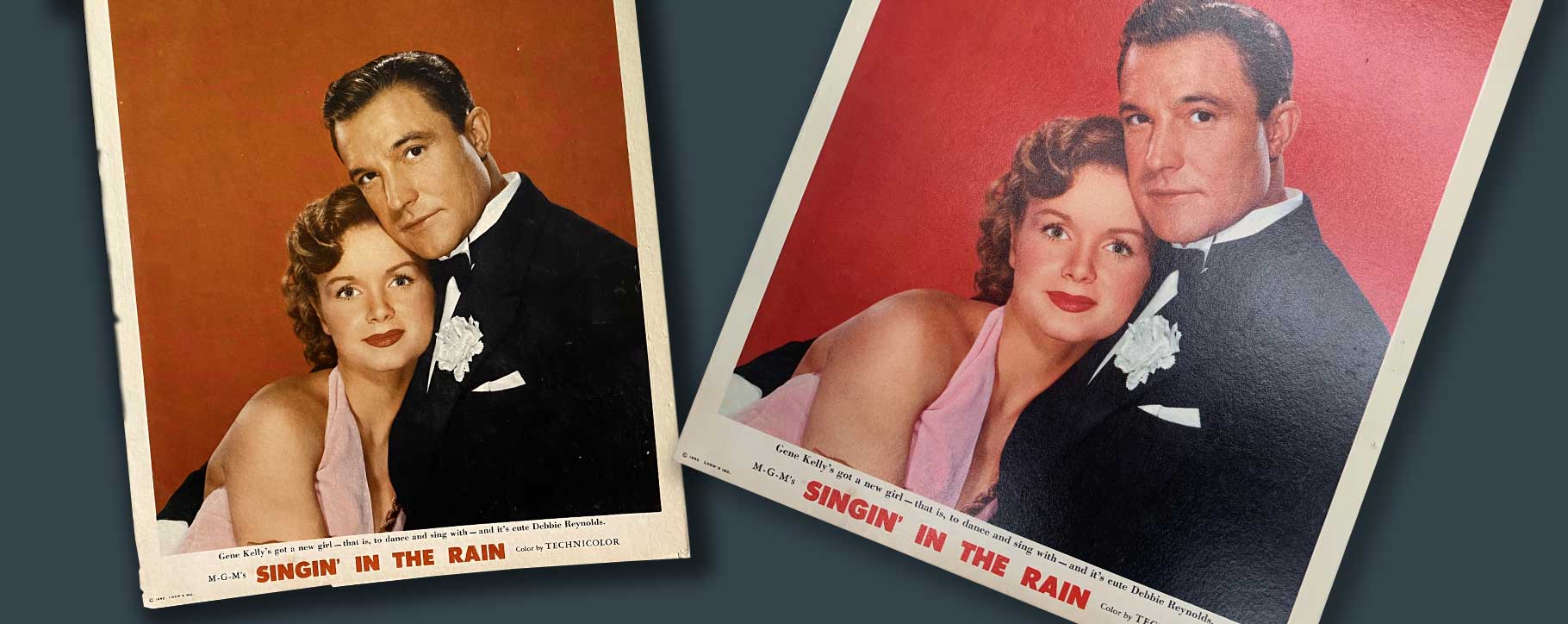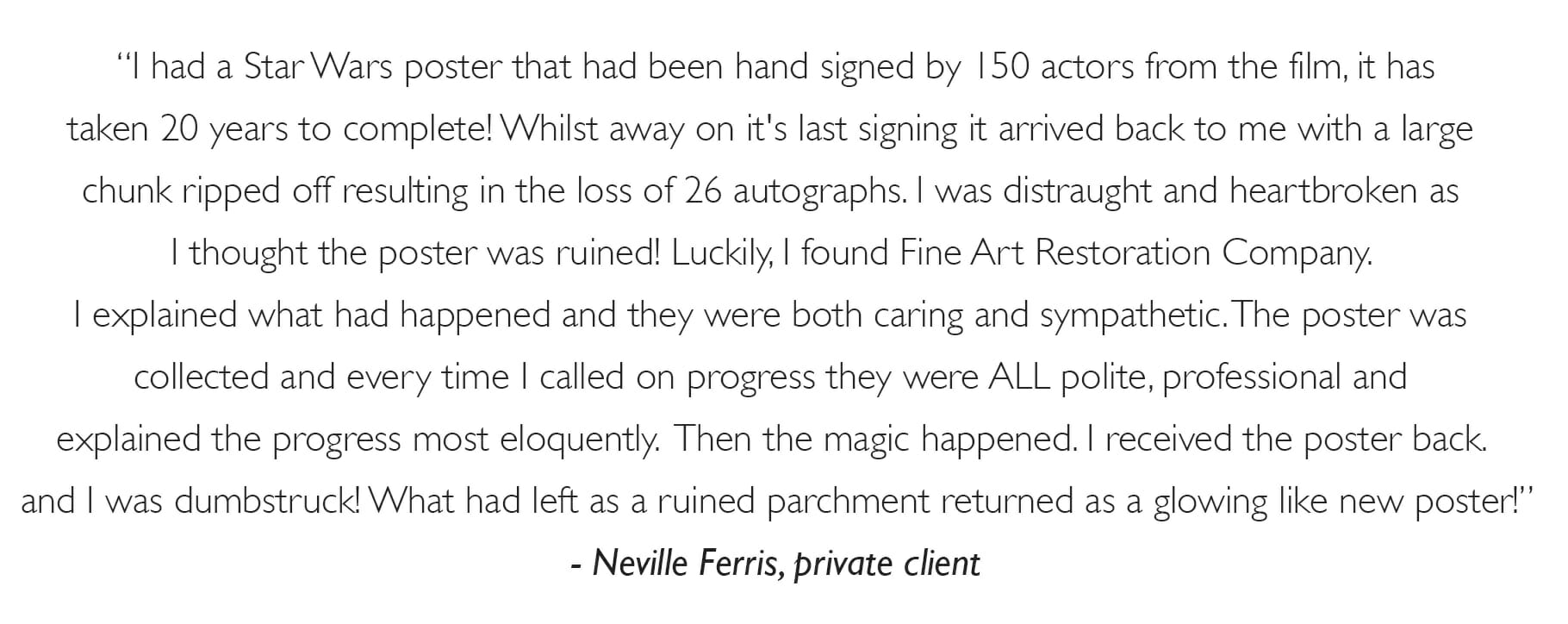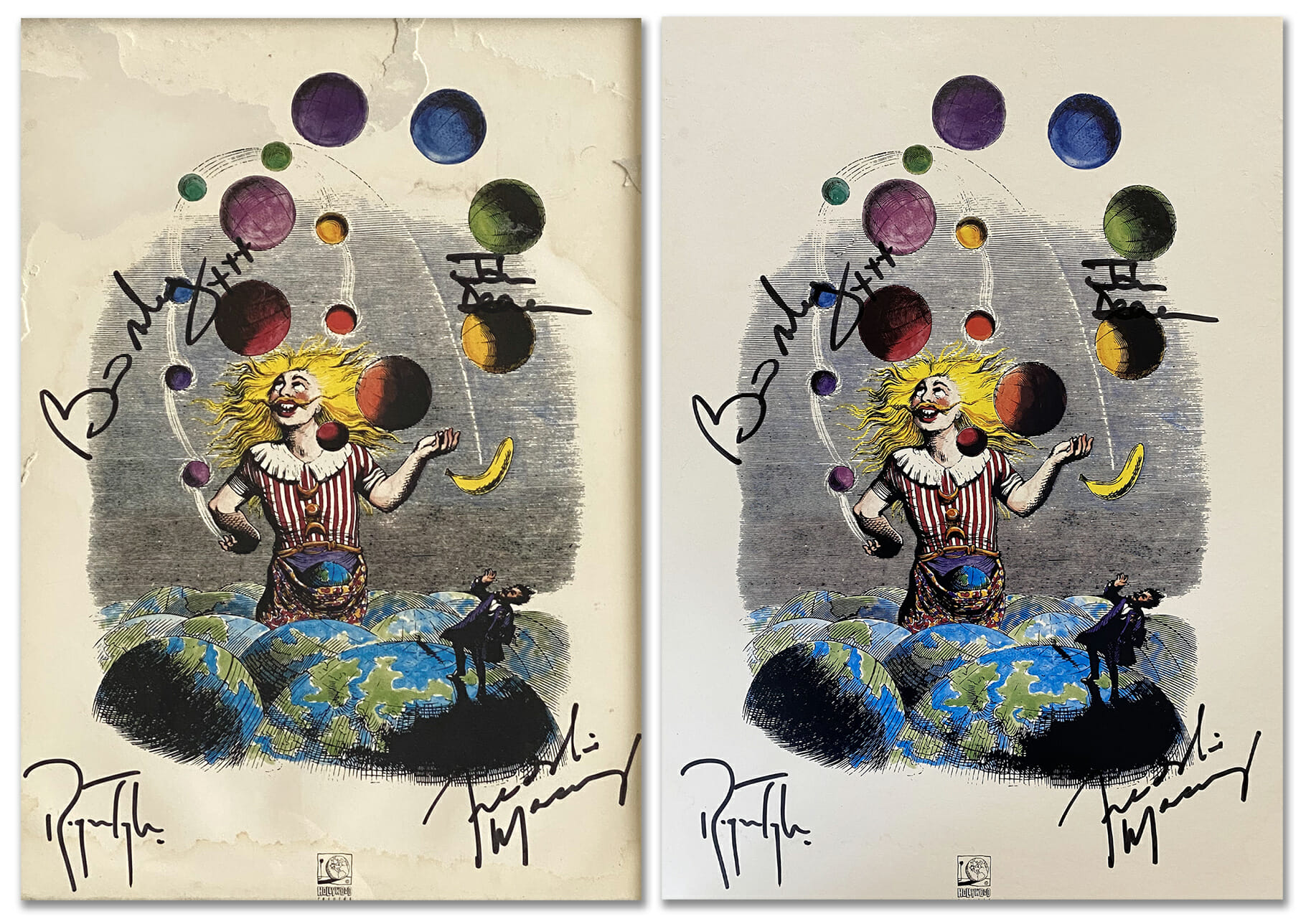
Movie memorabilia is an appealing area for many collectors, whether this is through connections to nostalgia or famous franchises, or the ever-rising monetary value or rare items. When collectibles are met with damage through natural or accidental means, it can be devastating and some may be more vulnerable to deterioration than others.
Works on paper, such as posters, lobby cards, postcards or flyers, may face high risk from their environment before and after their life as a marketing tool. Specifically, large and rare film posters which may have started their life on display in a public cinema may have risks associated with rough display techniques, mishandling, folding, and sunlight exposure. They may have also faced issues from poor storage conditions, water exposure, and even smoke before becoming a treasured artwork in a collector’s home and the contaminants of this may still lurk on the surface, causing deterioration over a long course of time.
However, the vulnerability of paper does not end when it is on display as memorabilia. Household environments can still lead to issues from mould, foxing, fading, accidental damage, tears, nicotine staining, and even issues following a domestic disaster, such as a leak or fire.
As memorabilia pieces can be entirely unique and impossible to replace, their preservation is extremely important. Swift intervention from a conservator following recent or historic damage will stop the deterioration from progressing to the point of complete decay.
When protecting a cinema poster…
- DO have it assessed for prior damage by our conservator
- DO keep away from sunlight or bright artificial lighting
- DO ensure even levels of humidity to prevent mould
- DO keep flat in a protective framing option
- DON’T roll or fold the poster when in storage
- DON’T display without checking for prior contaminants
- DON’T put on display without a frame or UV protection
- DON’T leave issues to worsen over time
Preserving film posters and lobby cards
Unlike traditional artworks on paper, film posters have often had a practical history in a cinema or entertainment space, where they may have been initially handled without care. Film posters date back to the end of the 19th century, with the first being associated with cinematic innovators the Lumiere Brothers. Today a rare or highly sought after film poster can reach between $20,000 to $500,000. Older film posters often come in varying sizes, but the most common style is known as a ‘One Sheet’ (27 x 41 inches portrait) or a ‘Quad’ (30 x 40 inches landscape).

Whilst posters can often be of great sentimental importance, they also reach high value at auction depending on their rarity, backstory and in some cases the inclusion of autographs from the featured cast. Like posters, lobby cards were also used as promotional tools and are now highly collectable amidst fans of classic Hollywood. These smaller pieces often include still scenes from the film itself and were used for display in the box office, measuring around 8 x 10 inches.
Original display cases, frames, and basic methods for displaying a poster or lobby card may have resulted in damage from tears or acidic elements such as tape or sticky tack adhering to the paper. They may also be brittle along the folded edges, leading to clean tears across these sections. Pinholes may also cause weakness in the corners of the piece. Even the rolling of a poster for a long period may lead to the gradual deterioration of stability, keeping the piece flat is recommended. Even if these issues have occurred historically, they could continue to destabilise and deteriorate the poster over decades, to the point of decay.
Fading and loss of colour are often due to being displayed in brightly lit locations, including on the outside of a building or in direct sunlight. Some ink may be more colourfast, causing a visual disturbance and loss of the original tones. The heat from sunlight and bright fluorescent lights may also cause brittle structure and browning of the paper. Fading is not something that can be restored, but preventive methods can be achieved to prevent any further issues.
Water damaged posters
Due to this practical past, posters may have faced water damage from rain or leaks in storage. This may leak to brittle areas which require stabilisation treatment from our paper conservator, as well as a strengthening backing tissue to ensure it is not at risk of further deterioration. Mould and foxing may also be present, this may spread as years go on. Our conservator can clear away these spores and discolouration with gentle, tailored solutions. Whether moisture damage is from past or recent exposure, it is recommended that it is analysed by our paper conservator to ensure that it is stable and if required, preventative methods can be carried out.
Smoke damaged posters
Visual disturbances may also be due to fire, smoke, or nicotine. These may be clear upon the piece, with burnt edges and areas of dark staining and residue, or lighter such as a thin layer of smoke or yellowing nicotine upon the surface. As with moisture staining, our conservator can reduce visual disturbances with a sensitive clean, the paper is ‘washed’ in a custom solution and stabilised on strengthening tissue paper. These atmospheric layers of discolouration may also contain acidic particles which would otherwise deteriorate the paper if left on the surface, so it is important that they are cleaned by a specialist conservator.
Nicotine may be present on older posters that have been located in public venues which would have allowed smoking throughout the cinema. Fire damage may also be more frequently seen on this type of collectible, as the original projection equipment would have been more vulnerable to catching alight.
Atmospheric residue, as well as signs of wear, were present on a set of lobby cards our conservator recently cleaned and restored. They featured promotional stills for the 1952 hit musical ‘Singin’ In The Rain’ which featured Gene Kelly and Debbie Reynolds. The bright colours were returned and the pieces were stabilised to ensure future preservation.

Damaged and torn posters
Accidental damage is another common issue facing posters, tears are especially common upon the thin paper which becomes more brittle over time through folds, pinholes, and mishandling. A prime example of accidental damage to a poster in its years as a piece of memorabilia was that of a much-loved Star Wars poster which our team restored in 2020. The signed poster had been ripped in transit, damaging decades of valuable and sentimental collecting. Our conservator was able to source a new piece that was seamlessly re-adhered to the original. You can read more about this amazing restoration here.

The value of cinema posters
- Rare copies of the poster for ‘Metropolis’ (1927) are owned by Leonardo DiCaprio, the Austrian National Library Museum and New York’s Museum of Modern Art. A fourth copy sold privately for $690,000 in 2012.
- There are only 3 copies of ‘The Mummy’ poster from 1932, in 1997 one sold for $435,000.
- In 2017 an Italian poster for ‘Casablanca’ from 1946 sold for $478,000.
- A rare quad for the James Bond film ‘From Russia With Love’ sold for £10,000 in 2012.
- A poster for ‘Dracula’ (1931) featuring Bela Lugosi sold for $525,800 in 2017.
- In 1982 nine thousand teaser posters were printed with the title ‘Revenge Of The Jedi’. As the name was later changed, these rare Star Wars posters are worth up to $3000 but many in the market are found to be forged.
Protective poster framing and storage
Posters should always be professionally framed to ensure they are on an appropriate mount which will reduce the risk of them sticking to the glass. Our team practices conservation approved techniques that avoid any use of acidic materials which could decay the paper over time.
We recommend that all posters and lobby cards are kept away from sunlight, as UV rays will increase the chances of fading. As faded works on paper cannot be restored to original tones, this type of protection is vital to prevent complete loss.

UV protective glazing options are available at 70-99% protection, as well as UV reducing film to put on windows. However, the best option is to ensure they are displayed in a shaded location. If a poster is in storage, it is recommended that it is kept flat and not folded or rolled, in a dry area with level humidity.
Our team is able to provide conservation approved framing options to enhance the preservation of the piece, if you are interested in having a tailored portfolio of options to choose from, please get in touch with a photograph, dimensions and the styles you have in mind for the piece.
For any queries and for the restoration of posters and related collector’s memorabilia, please contact our team via [email protected] and we will be happy to assist or complete the form below for a free, no obligation quote.






